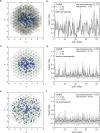Pseudosparse neural coding in the visual system of primates
- PMID: 33420410
- PMCID: PMC7794537
- DOI: 10.1038/s42003-020-01572-2
Pseudosparse neural coding in the visual system of primates
Abstract
When measuring sparseness in neural populations as an indicator of efficient coding, an implicit assumption is that each stimulus activates a different random set of neurons. In other words, population responses to different stimuli are, on average, uncorrelated. Here we examine neurophysiological data from four lobes of macaque monkey cortex, including V1, V2, MT, anterior inferotemporal cortex, lateral intraparietal cortex, the frontal eye fields, and perirhinal cortex, to determine how correlated population responses are. We call the mean correlation the pseudosparseness index, because high pseudosparseness can mimic statistical properties of sparseness without being authentically sparse. In every data set we find high levels of pseudosparseness ranging from 0.59-0.98, substantially greater than the value of 0.00 for authentic sparseness. This was true for synthetic and natural stimuli, as well as for single-electrode and multielectrode data. A model indicates that a key variable producing high pseudosparseness is the standard deviation of spontaneous activity across the population. Consistently high values of pseudosparseness in the data demand reconsideration of the sparse coding literature as well as consideration of the degree to which authentic sparseness provides a useful framework for understanding neural coding in the cortex.
Conflict of interest statement
The authors declare no competing interests.
Figures







Similar articles
-
Sparse coding in striate and extrastriate visual cortex.J Neurophysiol. 2011 Jun;105(6):2907-19. doi: 10.1152/jn.00594.2010. Epub 2011 Apr 6. J Neurophysiol. 2011. PMID: 21471391 Free PMC article.
-
Sparse coding models can exhibit decreasing sparseness while learning sparse codes for natural images.PLoS Comput Biol. 2013;9(8):e1003182. doi: 10.1371/journal.pcbi.1003182. Epub 2013 Aug 29. PLoS Comput Biol. 2013. PMID: 24009489 Free PMC article.
-
Sparseness of the neuronal representation of stimuli in the primate temporal visual cortex.J Neurophysiol. 1995 Feb;73(2):713-26. doi: 10.1152/jn.1995.73.2.713. J Neurophysiol. 1995. PMID: 7760130
-
Representation of Naturalistic Image Structure in the Primate Visual Cortex.Cold Spring Harb Symp Quant Biol. 2014;79:115-22. doi: 10.1101/sqb.2014.79.024844. Epub 2015 May 5. Cold Spring Harb Symp Quant Biol. 2014. PMID: 25943766 Free PMC article. Review.
-
Surround suppression supports second-order feature encoding by macaque V1 and V2 neurons.Vision Res. 2014 Nov;104:24-35. doi: 10.1016/j.visres.2014.10.004. Epub 2014 Oct 23. Vision Res. 2014. PMID: 25449336 Free PMC article. Review.
References
-
- Barlow, H. B. in Sensory Communication (ed. Rosenblith, W.) Ch. 13, 217–234 (MIT Press, 1961).
-
- Földiák, P. In Handbook of Brain Theory and Neural Networks, 2nd edn (ed. Michael, A. Arbib) 1064–1068 (MIT Press, 2002).
Publication types
MeSH terms
LinkOut - more resources
Full Text Sources
Other Literature Sources
Miscellaneous

